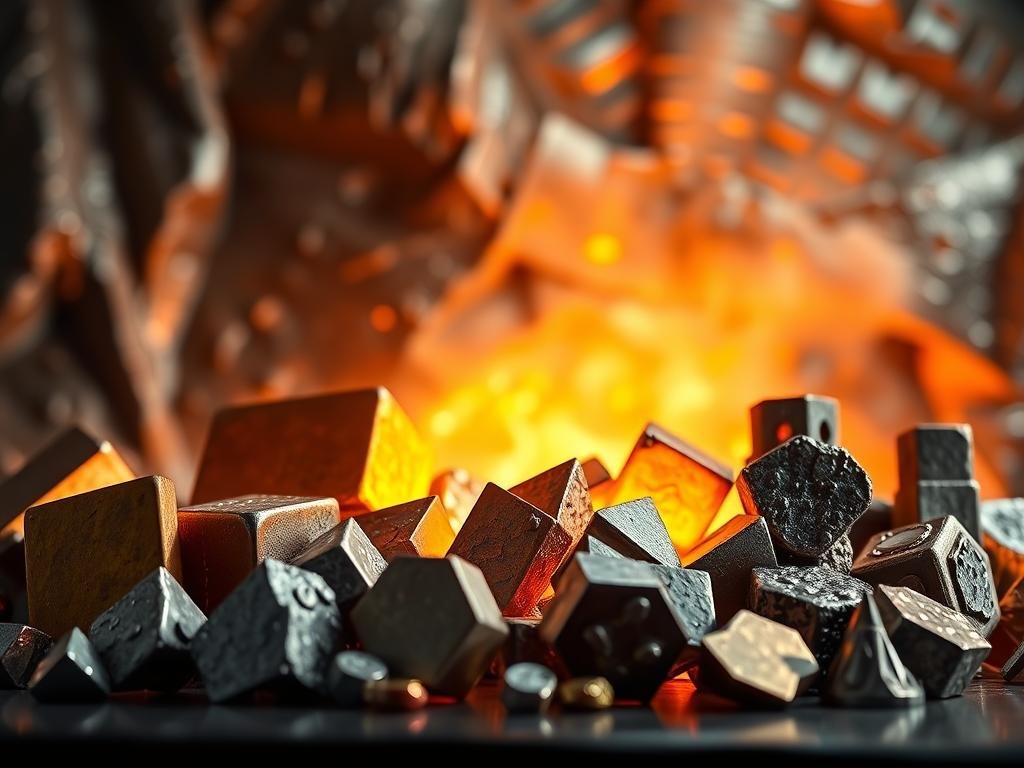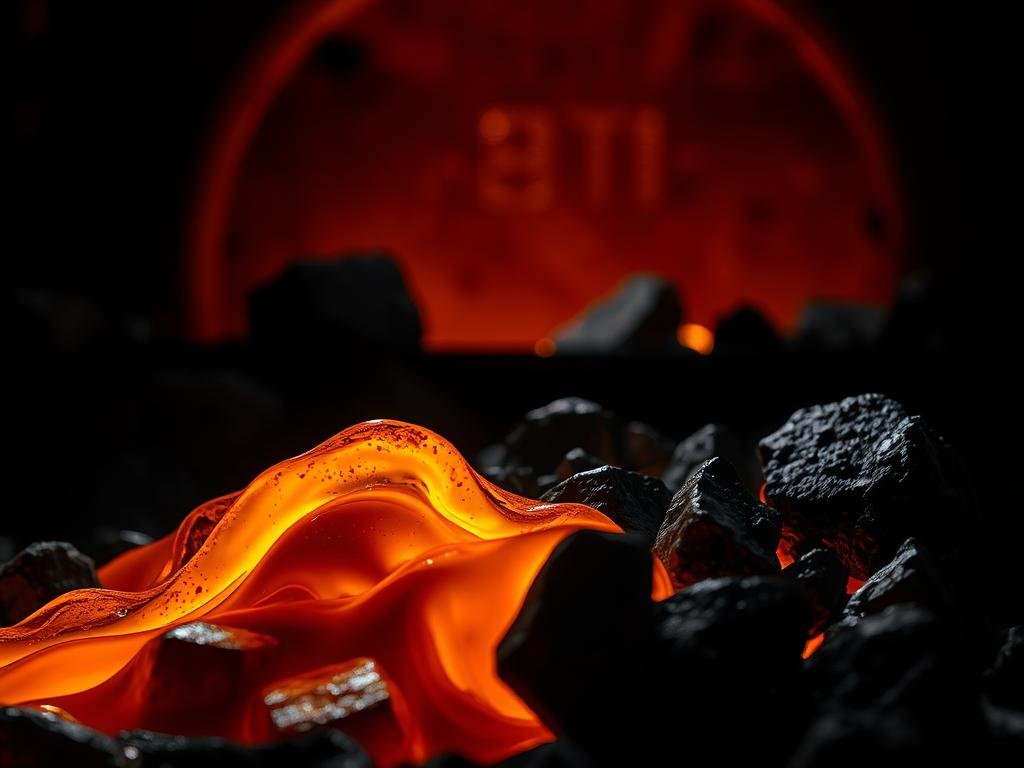Metals are known for their resilience in harsh environments, including high temperatures. Equipment such as combustion engines, jet engines, and furnaces are frequently subjected to extreme temperatures that can melt some 金屬.
Understanding the of various 金屬 is crucial when selecting materials for high-temperature applications. The melting point is a critical factor in determining a metal’s suitability for use in extreme environments.
Tungsten is known to have an exceptionally high 熔點, making it a prime candidate for use in high-temperature applications. This article will explore why tungsten leads the pack and examine the properties that make certain 金屬 比其他人更能抵抗高溫。
理解金屬的熔點
The melting point of a metal is a critical parameter that influences its usability in different contexts. It is one of the most significant temperatures that a metal can achieve during a metalworking process or as a result of an application.
什麼是熔點?
熔點是金屬由固態轉變為液態的溫度。這一轉變至關重要,因為它決定了金屬在不同熱條件下的行為。 High melting metals are particularly valuable in applications where thermal stability is required.
Why Melting Points Matter in Material Science
Melting points serve as critical parameters in material selection for applications involving thermal exposure. They help engineers avoid catastrophic failures in high-temperature environments. 下表突顯了熔點在材料科學各方面的重要性。
| Aspect | 熔點的重要性 |
|---|---|
| Material Selection | 有助於選擇能夠承受高溫的材料。 |
| 製造流程 | Essential for designing appropriate tooling and equipment. |
| 熱穩定性 | 指示材料在熱應力下的表現方式。 |
What Metal Has the Highest Melting Point?
Tungsten stands out as the metal with the highest melting point, a characteristic that has made it indispensable in various high-temperature applications. This distinction is not merely a matter of curiosity; it underpins many of the technological advancements in industries ranging from lighting to aerospace.
鎢:冠軍之王
Tungsten’s melting point of 3420°C (6150°F) is unmatched among metals, making it a critical component in high-temperature environments. Its exceptional thermal stability is a key factor in its widespread adoption in industrial processes. The use of tungsten in applications such as rocket nozzles and high-temperature furnace components is a testament to its durability and resistance to thermal stress.
歷史發現與意義
鎢於1783年由西班牙化學家胡安·何塞(Juan José)和福斯托·埃爾胡亞(Fausto Elhuyar)發現。“鎢”這個名字來自瑞典語“tung sten”,意為“重石”,反映其高密度。起初,其非凡的熔點並未被充分重視,直到19世紀末和20世紀初高溫應用的發展。
一些重要的歷史里程碑包括鎢絲燈絲的發展,這改變了人造照明,並且在第一次世界大戰和第二次世界大戰期間具有戰略重要性,特別是在高速切削工具和穿甲彈藥方面的軍事應用。
| 年 | Event | 意義 |
|---|---|---|
| 1783 | 鎢的發現 | 由西班牙化學家從沃爾夫拉姆礦石中分離出來 |
| Late 19th Century | Development of Tungsten Filaments | Revolutionized artificial lighting |
| World War I & II | 軍事應用 | 用於高速切削工具和穿甲彈 |
熔點最高的十大金屬
Metals that can withstand extremely high temperatures are crucial for various industrial applications. The following list highlights the top 10 metals known for their exceptionally high melting points.
1. 鎢 (W) – 3420°C/6150°F
鎢以其熔點3420°C位居首位。由於其卓越的硬度和耐熱性,廣泛用於高溫應用,包括爐子零件和火箭噴嘴。
2. 鍺 (Re) – 3180°C
鉻是一種具有非常高熔點的金屬,使其適用於噴氣引擎零件和其他高溫應用,在這些應用中其強度和抗腐蝕性非常重要。
3. Tantalum (Ta) – 2966°C
Tantalum’s high melting point and resistance to corrosion make it ideal for electronic components and chemical processing equipment.
4. Molybdenum (Mo) – 2620°C
Molybdenum is used in steel alloys and is known for its strength at high temperatures, making it suitable for furnace parts and other high-temperature applications.
5. Niobium (Nb) – 2468°C
Niobium is used in aerospace applications due to its high melting point and ability to withstand extreme temperatures.
6. Iridium (Ir) – 2454°C
Iridium is one of the densest elements and has a high melting point, making it useful for applications requiring high corrosion resistance and strength at high temperatures.
7. Hafnium (Hf) – 2227°C
Hafnium has a melting point of 2227°C and is known for its ability to absorb neutrons, making it crucial for nuclear reactor control rods. Its high-temperature resistance and corrosion resistance also make it valuable for other applications.
- Hafnium (Hf) claims the seventh position with a melting point of 2,227°C (4,041°F), offering an excellent combination of high-temperature resistance and nuclear properties.
- This transition metal possesses an exceptional ability to absorb neutrons, making it invaluable for nuclear applications.
- Hafnium maintains good mechanical strength at elevated temperatures and offers good corrosion resistance.

The metals listed above are critical for various high-temperature applications, including aerospace, nuclear, and industrial processes.
Properties That Make Tungsten Exceptional
Tungsten’s impressive attributes, including its high melting point, make it an exceptional metal. Its unique combination of properties makes it valuable for various applications.
未匹配的熱穩定性
Tungsten exhibits exceptional thermal stability, maintaining its structure even at extremely high temperatures. This property makes it ideal for applications in harsh environments.
Density and Strength Characteristics
Tungsten has a high density and exceptional strength, making it suitable for applications requiring high mass and durability. Its strength-to-weight ratio is particularly valuable in aerospace and defense industries.
耐腐蝕性能
鎢在許多環境中展現出優異的耐腐蝕性,尤其是在室溫下。當暴露於高溫氧氣中時,它會形成一層保護性的氧化層。
| Property | 描述 | 好處 |
|---|---|---|
| 耐腐蝕 | Resistant to most acids and bases at room temperature | Valuable in harsh chemical environments |
| 熱穩定性 | Maintains structure at high temperatures | Ideal for high-temperature applications |
| Density and Strength | 高密度與卓越的強度 | Suitable for aerospace and defense industries |
影響金屬熔點的因素
Understanding the factors that affect a metal’s melting point is crucial for various industrial and scientific applications. The melting point of a metal is not a fixed property; it can be influenced by several factors.
Atomic Structure and Bonding
The atomic structure and bonding of a metal play a significant role in determining its melting point. Metals with strong atomic bonds require more energy to break, resulting in higher melting points. The arrangement of atoms in the crystal lattice also affects the melting behavior.
External Pressure Effects
External pressure is another factor that can influence a metal’s melting point. Generally, an increase in pressure results in a higher melting point, as it becomes more difficult for the atoms to gain enough energy to break free from their lattice structure.
Impurities and Alloy Formation
Impurities and alloy formation significantly affect a metal’s melting point. The presence of impurities can lower the melting point by disrupting the crystal structure. Alloying elements can be added intentionally to modify the melting behavior for specific applications.
| 因素 | 熔點的影響 |
|---|---|
| Atomic Structure and Bonding | Influences melting point through bond strength |
| 外部壓力 | Generally increases melting point with increased pressure |
| Impurities and Alloying | Can lower or modify melting point |
As noted by a materials scientist, “The melting point of a metal can be altered by even the tiniest amount of impurities.” This highlights the importance of considering these factors in material selection and processing.
“The relationship between composition and melting point in alloys is often represented in phase diagrams, which serve as crucial tools for materials scientists and engineers designing materials for specific thermal requirements.”
鎢的高溫應用
Tungsten’s exceptional properties make it a crucial material in various high-temperature applications. Its high melting point and excellent electrical conductivity render it indispensable in numerous industrial and technological contexts.
Aerospace and Jet Engine Components
Tungsten is used in aerospace and jet engine components due to its ability to withstand extremely high temperatures. It is utilized in rocket nozzles and other critical components where its high melting point and resistance to corrosion are vital.
Industrial Furnaces and Heating Elements
In industrial furnaces, tungsten is used to make heating elements that can operate at very high temperatures. These elements are crucial for processes such as sintering and heat treatment, where maintaining precise temperatures is essential.
Electronics and Lighting Applications
Tungsten’s high melting point made it the definitive material for incandescent light bulb filaments. In modern electronics, it is used for heat sinks, interconnects, and electrical contacts due to its combination of electrical conductivity and high-temperature resistance. Additionally, tungsten’s ability to emit electrons efficiently at high temperatures makes it valuable for cathodes in X-ray tubes and electron microscopes.
The unique properties of tungsten have also found new applications in emerging technologies, such as high-temperature superconductors, where it serves as a substrate material. Its exceptional resistance to electromigration makes it valuable in high-reliability electronic components for aerospace, military, and medical applications.
Comparing Tungsten to Common Metals
Tungsten stands out among metals due to its exceptionally high melting point. This characteristic makes it invaluable in high-temperature applications. To understand its advantages, it’s essential to compare tungsten with other metals.
Tungsten vs. Steel and Iron Alloys
Tungsten’s melting point of 3,422°C far exceeds that of steel and iron alloys, which typically melt between 1,500°C to 2,000°C. This significant difference makes tungsten ideal for extreme environments where other metals would fail.
Tungsten vs. Titanium
Titanium has a melting point of around 1,668°C, which is considerably lower than tungsten’s. While titanium offers excellent strength-to-weight ratio and corrosion resistance, tungsten’s high melting point gives it a unique advantage in high-temperature applications.
Tungsten vs. Other Refractory Metals
Refractory metals like rhenium, tantalum, and molybdenum have high melting points, but tungsten remains the highest. For instance, rhenium melts at 3,180°C, and molybdenum at 2,620°C. The table below summarizes the melting points of these metals.
| 金屬 | 熔點 (°C) |
|---|---|
| 鎢 | 3,422 |
| Rhenium | 3,180 |
| 鉬 | 2,620 |
| Tantalum | 2,996 |
Challenges of Working with High Melting Point Metals
Metals with exceptionally high melting points, like tungsten, require specialized handling and processing techniques. These metals are crucial for various high-temperature applications, but their unique properties pose significant challenges.
Manufacturing and Processing Difficulties
The extraction and refining of high-melting-point metals involve complex, energy-intensive processes. For instance, tungsten and rhenium require specialized equipment and expertise, adding substantial costs to finished components.
- The high melting points of these metals make them difficult to shape and form.
- Specialized techniques are needed to process these metals without damaging their structure.
Cost and Availability Considerations
High-melting-point metals can be expensive to produce and process, limiting their use in certain applications. Rhenium, for example, is one of the rarest elements in Earth’s crust, with annual global production ranging from 40 to 50 tonnes.
| 金屬 | 熔點 (°C) | Annual Production (tonnes) |
|---|---|---|
| 鎢 | 3420 | Several thousand |
| Rhenium | 3180 | 40-50 |
The Science Behind High Melting Points
Understanding the melting behavior of metals requires insight into their atomic bonds and energy requirements. The melting point is a critical property that determines a metal’s suitability for high-temperature applications.
Atomic Bonds and Energy Requirements
The strength of interatomic bonds in metals directly influences their melting points. Metals like tungsten, with its exceptionally high melting point of 3420°C, owe this property to the strong bonds between their atoms. The energy required to break these bonds and transition the metal from a solid to a liquid state is substantial.
The Relationship Between Melting and Boiling Points
A strong correlation exists between the melting and boiling points of metals, reflecting the strength of their interatomic bonds. For instance, rhenium has both the second-highest melting point (3180°C) and the highest boiling point (5627°C) among metals. Understanding this relationship is crucial for predicting material behavior in extreme environments.
- The ratio between melting and boiling points, known as Trouton’s rule, provides insights into the nature of bonding within the material.
- The wide gap between these points in high-melting metals enables specialized processing techniques like liquid phase sintering.

Conclusion: Why Tungsten Remains Irreplaceable
With its unparalleled melting point, tungsten is unmatched.
Tungsten’s highest melting point of 3,422°C is its most distinctive characteristic, making it ideal for applications requiring resistance to extreme temperatures. Its unique combination of high density, mechanical strength, and wear resistance is irreplaceable in numerous specialized applications.
Beyond its thermal properties, the continued development of tungsten alloys and composites has expanded its utility, addressing limitations like brittleness at room temperature while maintaining its high-temperature performance. As industries push the boundaries in extreme environments, from aerospace to energy production, tungsten’s properties ensure it remains crucial.
Tungsten’s significance is further underscored by its good high-temperature strength and corrosion resistance, making it a cornerstone in humanity’s technological toolkit.
